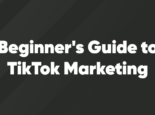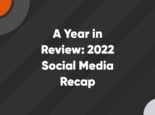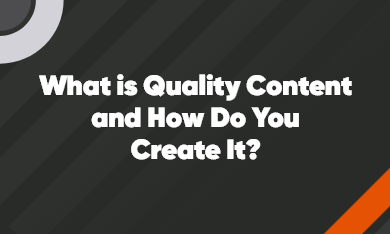
How to Create Content for Each Stage of the Buyer’s Journey

Every marketer should have at least a high-level understanding of the three stages of the buyer’s journey (also sometimes called the marketing funnel): awareness, consideration, and decision.
But even if you’re aware of these stages, the buyer’s journey can be complex and not as straightforward as it may seem. Consumers are more informed and hold a ton of power now. That is why it’s important to understand your customer’s profile and their thought processes. By doing this, you will be able to carefully create content that resonates with them at each stage of their journey.
In this post, we will go over the following:
- What the buyer’s journey is
- The importance of content creation for the buyer’s journey
- Examples of content for each stage of the buyer’s journey
What is the Buyer’s Journey?
Simply put, the buyer’s journey consists of all the processes, thoughts, and events that lead a customer to make a purchase. Oftentimes, the journey can extend into a post-purchase phase, as well. The buyer’s journey essentially maps out the customer’s path to purchase.
Why Creating Content for Each Stage of the Buyers Journey is Important
You can’t be everything to everyone. That is a golden rule in marketing. That is why it’s important to identify your ideal customer. However, identifying your ideal customer is just one piece of the puzzle. Once you identify your ideal customer, the next step is to understand them. When we say understand, we mean deeply resonating with how they think, feel, process information, and make decisions.
If you don’t clearly understand your customer, you run the risk of creating a disconnect between what your company is offering and what your customer needs/wants. In terms of content, this means creating content that your audience and readers can’t relate to which can mean losing them as customers.
To avoid potential attrition, it is important to create content based on a given user’s current stage in the buyer’s journey. It may sound easier said than done to create content for people at the right place and the right time. With the help of our buyer’s journey content guide, you will be able to craft content for your audience for whatever stage of the journey they’re in.
Content for Each Stage of the Buyer’s Journey
Marketing is all about meeting people where they’re at. That is why it’s important to make sure your content is targeted for each stage of the journey. Each stage of the buyer’s journey gets them closer to making a purchase. Below is a breakdown of a customer’s typical behavior in each stage:
- Awareness: People are looking for answers and education at this stage. They are just noticing they have a problem that needs to be addressed.
- Consideration: At this stage, your audience is beginning to research whether your product or service is going to address their specific pain points. They are weighing all their options.
- Decision: At this stage, the buyer is ready to buy. They have researched and figured out what will solve their problem.
Types of Content for the Awareness stage
Remember, at this point, the buyer is simply gathering information and is not ready to make any decisions. The lead value is low because you are not sure whether they will buy from you. However, with the proper content, you can increase the lead value to help bring them further through the funnel. At this stage, the best types of content are:
Blog Posts
Blog posts are great pieces of content to share in the awareness stage. By creating topics and articles that address their pain points, your audience can easily access this through a quick Google search.
Blog posts written in the awareness stage should be:
- Informative and valuable to your audience. Your post should answer questions and address each pain point your audience is experiencing.
- Free of clickbait content, sales copy, or branded information. Remember, they are just looking for guidance and education.
- Clear and concise. Blog posts should not be too short, otherwise, you will be unable to provide enough valuable information, but they should also not be too long. We recommend blog posts to be at least 500 words in length.
Social media posts and videos
Social media is the best of both worlds when it comes to content. Not only can you promote your content on social media, but you can also create your own content solely for your social channels. On social media, you can share helpful information and tips with your audience.
Below is an example of how Perrill used a thoughtful and engaging post that shared marketing tips for our audience on LinkedIn.
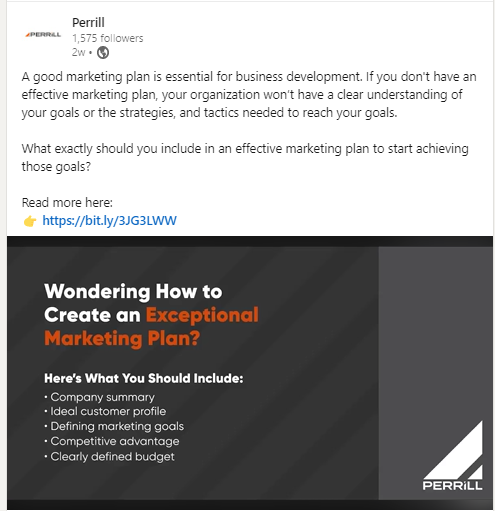
Video marketing is also becoming highly effective. 86% of marketers today currently use video marketing. How-to and informational types of videos are perfect for the awareness stage. This will help your audience learn new skills to solve their pain points.
Infographics
Infographics can be highly effective in this stage of the buyer’s journey. For an infographic to provide real tangible value to your audience, it needs to relay the information in a highly informative but also creative and engaging way.
Infographics are an effective tool because they are incredibly easy for your readers to digest. It is much easier for someone to read and gather key points from an infographic than it is to read a 2,000-word article.
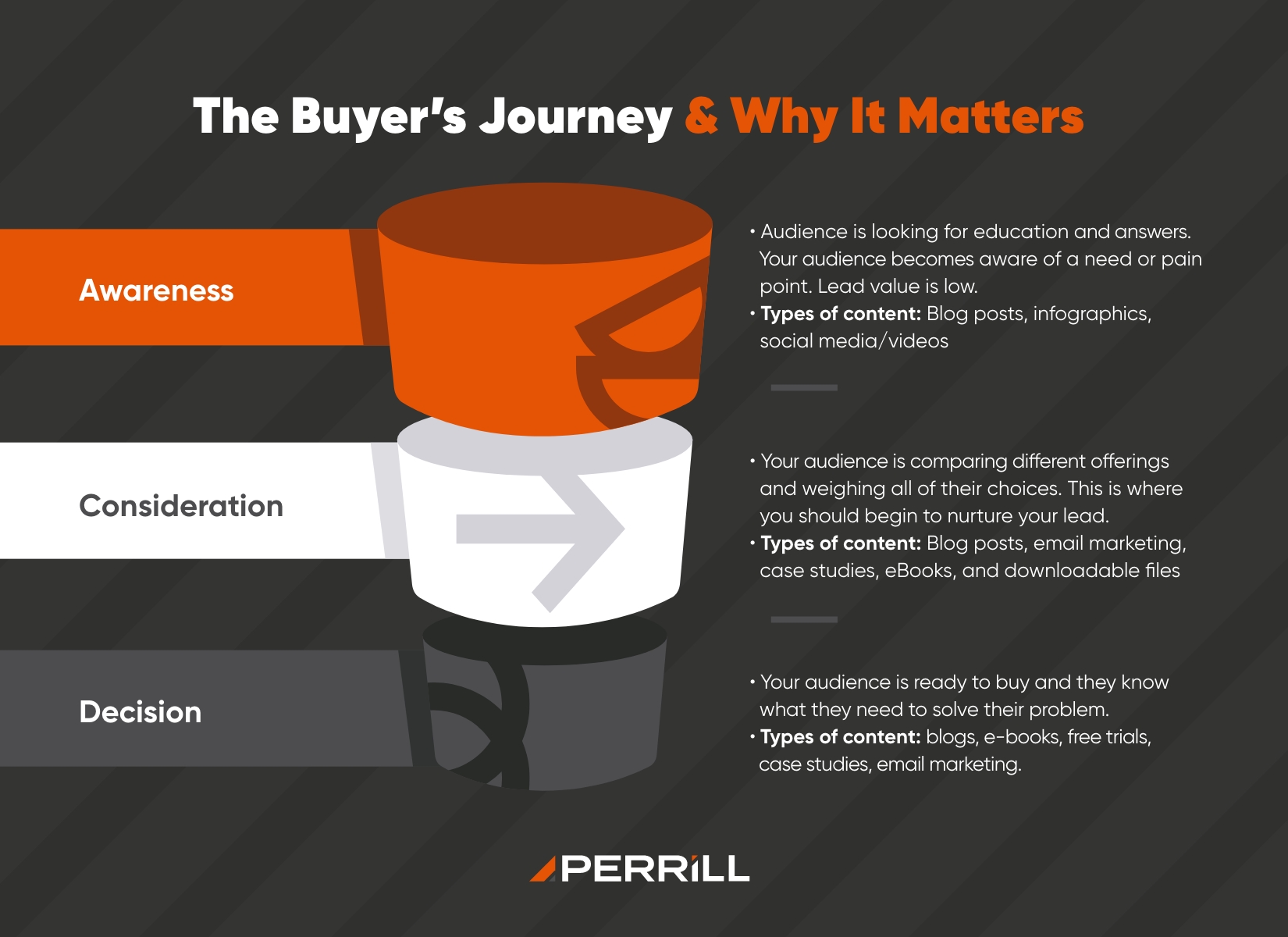
Types of Content for the Consideration Stage
In the consideration stage, the buyer is comparing different products and services. The lead status is of greater value, and this is where you will begin to nurture the lead. At this point, you want to begin to build connections with your audience and engage with them more deeply. A great channel to send this information through is email. You can make your message more personalized and more targeted for each contact you send it to.
Good types of content for the consideration stage are:
Blog Posts
Blog posts will be good to use at any stage of the buyer’s journey. It all comes down to the types of content you are writing about and sharing. Remember, your buyer is comparing options from different brands at this point, so at this stage, your blog posts should be more targeted to your company’s offerings. In these blogs, you’ll want to talk about how your product or services can help solve their problems.
Case Studies
Now that the buyer is beginning to compare different product offerings, case studies can be a highly effective tool to use. Case studies show that your company can deliver good results. A good case study will include real numbers from your data, tell the full customer story from start to finish, and be relatable to your target audience.
eBooks and Downloadable Files.
eBooks and downloadable files are great for this stage because you are giving the buyer something of tangible value. When creating a good downloadable file make sure the customer will get real value from it. Free templates, how-to’s, and guides make excellent downloadable files.
Types of Content for the Decision Stage
At this point, the buyer is ready to make a purchase. They have weighed all their options and they know what is going to solve their pain points. This stage is where you want to showcase all the benefits that your product has that your competitors can’t even match. Your website and emails are great channels for sharing your content. Good content formats for the decision stage are:
Free Trials and Samples
Free trials and samples are a great way to get the buyer to purchase your product. Free trials and samples are risk-free, and the buyer does not have to commit to anything right away. After all, would anyone buy a brand-new car without giving it a test drive first? Probably not.
For example, say you operate a gym, and you want someone to try out your new facility and the brand-new yoga classes you offer. Offering them a 2-week free membership to your gym, or a week of free yoga classes is a great way for someone to see if they like your gym over your competitors.
FAQs
FAQs (or frequently asked questions) can target user concerns and hesitations by answering questions they may have. FAQ sections are also a great way to target keywords. To find the top questions your users are looking for, we suggest performing keyword research with tools like SEMrush.
Demos
When customers reach this part in their journey, they should know the value that your product or service is delivering. Sometimes all a consumer needs to commit is to see your product in action.
A demo does not need to be complex; it can be as simple as a short video that shows the process and experience of your product in use.
A great example of this is furniture shopping. Businesses now are using a virtual experience that lets you place the furniture in a selected room to see how it would look before buying it. Target’s example below is a visual of how they used AR for their furniture placement.

Source: Target
Putting it All Together
The buyer’s journey will be different for each buyer and company. It is not something that can be copied and pasted from one to another. What is most important is to meet your customer where they are to create content that is targeted for each stage of their journey. As they progress through the funnel, their needs evolve, and it is important your content does the same. If you can do it well, you will not only gain new customers, but you will build connections and relationships with your customers that can last for years beyond discovery.
Do you need help connecting with your customers through engaging content? Let’s talk, grab some time on our calendar, and let our talented team of marketing experts help you win online.
Author
Amelia Opheim
Categories
Date
Explore with AI
Join Our Newsletter

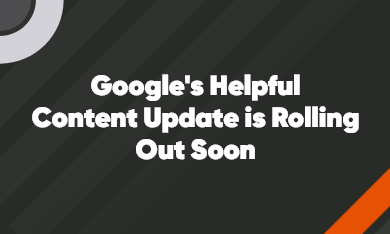
Google’s Helpful Content Update is Rolling Out Soon

